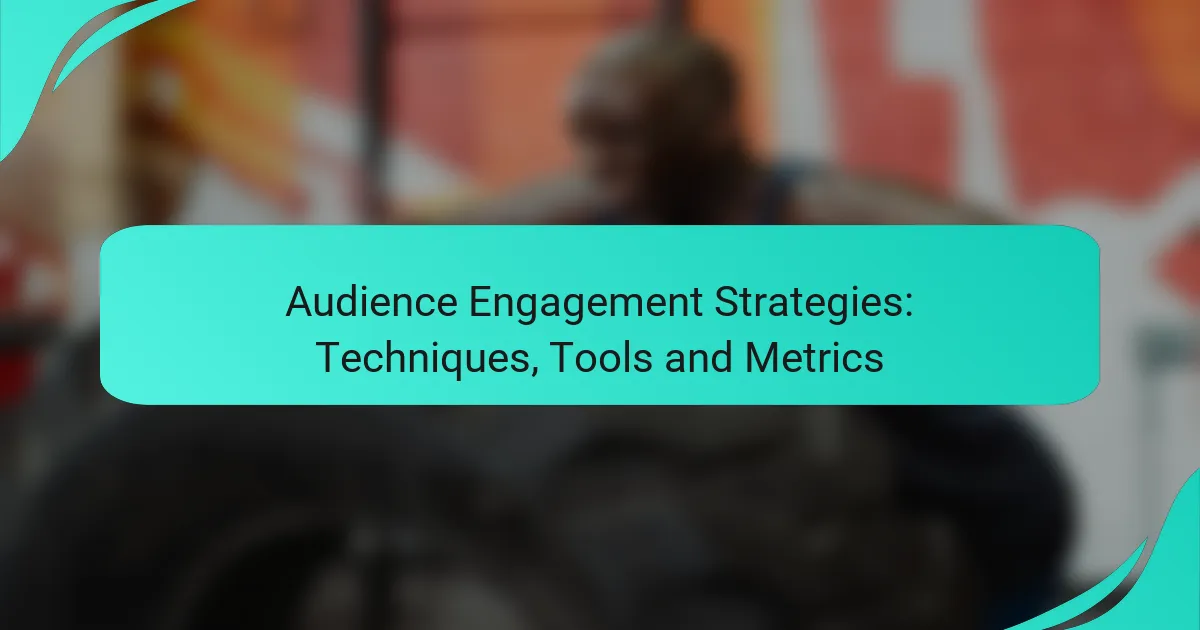Engaging your audience effectively is crucial for maximizing the impact of display advertising. By employing techniques such as personalized content, interactive formats, and social media integration, you can significantly boost user interaction and conversion rates. Utilizing the right tools allows for better understanding of audience preferences, while key metrics help measure engagement success and inform future strategies.

What are effective audience engagement strategies for display advertising?
Effective audience engagement strategies for display advertising focus on capturing attention and fostering interaction. Techniques such as personalized content delivery, interactive ad formats, and social media integration can significantly enhance user engagement and conversion rates.
Personalized content delivery
Personalized content delivery tailors advertisements to individual user preferences and behaviors. By utilizing data analytics and user segmentation, advertisers can create targeted messages that resonate with specific audiences, increasing the likelihood of engagement.
For instance, using browsing history or demographic information, a travel agency might display ads for vacation packages that align with a user’s previous searches. This approach can improve click-through rates by a notable margin.
Interactive ad formats
Interactive ad formats encourage users to engage directly with the advertisement, making the experience more memorable. Formats such as quizzes, polls, or clickable videos can draw users in and prompt them to take action.
For example, a fashion retailer might use a “design your outfit” interactive ad, allowing users to mix and match clothing items. This not only engages users but also provides valuable insights into their preferences.
Social media integration
Integrating display advertising with social media platforms can amplify reach and engagement. By sharing ads on social networks, brands can tap into existing communities and encourage sharing, which can lead to organic growth.
For instance, a brand might run a campaign where users can share their experiences with a product on social media, incentivizing participation through discounts or giveaways. This strategy can create a buzz and enhance brand visibility.
Gamification techniques
Gamification techniques incorporate game-like elements into advertising to boost user interaction. By adding rewards, challenges, or competitions, brands can motivate users to engage more deeply with their ads.
An example is a loyalty program that rewards users for completing specific actions, such as watching a video or sharing content. This not only increases engagement but also builds brand loyalty over time.
Email marketing campaigns
Email marketing campaigns can complement display advertising by nurturing leads and encouraging repeat engagement. By sending personalized emails that highlight relevant offers or content, brands can keep their audience informed and interested.
For effective campaigns, consider segmenting your email list and tailoring messages to different audience groups. A well-timed email with a special offer can significantly boost conversions, especially if it aligns with a recent display ad campaign.

How can tools enhance audience engagement?
Tools can significantly enhance audience engagement by providing insights, streamlining communication, and facilitating content management. By leveraging the right tools, organizations can better understand their audience’s preferences, optimize their outreach strategies, and ultimately foster stronger connections.
Analytics platforms like Google Analytics
Analytics platforms such as Google Analytics help track user behavior on websites, offering valuable insights into audience engagement. These tools provide metrics like page views, session duration, and bounce rates, which can guide content strategy and marketing efforts.
To effectively use analytics, focus on key performance indicators (KPIs) that align with your engagement goals. Regularly review data to identify trends and adjust your strategies accordingly. Avoid getting lost in excessive data; instead, concentrate on actionable insights that drive improvement.
Social media management tools such as Hootsuite
Social media management tools like Hootsuite enable organizations to schedule posts, monitor engagement, and analyze performance across multiple platforms. These tools streamline the process of interacting with audiences, making it easier to maintain a consistent online presence.
When using social media tools, prioritize platforms where your audience is most active. Utilize features like audience segmentation and targeted messaging to enhance engagement. Regularly assess your social media metrics to refine your approach and avoid common pitfalls like overposting or neglecting responses.
Customer relationship management (CRM) systems
CRM systems help manage interactions with current and potential customers, enhancing audience engagement through personalized communication. By storing customer data, these systems enable tailored marketing campaigns and improved customer service.
Choose a CRM that integrates well with your existing tools and allows for easy data analysis. Regularly update customer information to maintain accuracy and relevance. Avoid overwhelming customers with excessive communication; instead, focus on meaningful interactions that foster loyalty.
Content management systems (CMS) like WordPress
Content management systems such as WordPress facilitate the creation, management, and distribution of content, which is crucial for audience engagement. These platforms offer user-friendly interfaces and customizable features that allow for effective content strategies.
When selecting a CMS, consider factors like ease of use, scalability, and available plugins. Regularly update your content to keep it fresh and relevant, and utilize SEO best practices to enhance visibility. Avoid neglecting user experience; ensure your site is easy to navigate and mobile-friendly to retain audience interest.

What metrics should be used to measure engagement?
To effectively measure audience engagement, focus on key metrics such as click-through rates, conversion rates, social media engagement rates, and time spent on site. These metrics provide insights into how well your content resonates with your audience and can guide improvements.
Click-through rates (CTR)
Click-through rate (CTR) measures the percentage of users who click on a link compared to the total number of users who view the content. A higher CTR indicates that your content is compelling and encourages action. Aim for a CTR of around 2-5% for effective campaigns, but this can vary by industry.
To improve CTR, use clear and enticing call-to-action (CTA) buttons, optimize headlines, and ensure your content is relevant to your target audience. Regularly analyze your CTR to identify trends and adjust strategies accordingly.
Conversion rates
Conversion rate refers to the percentage of users who complete a desired action, such as making a purchase or signing up for a newsletter. This metric is crucial for assessing the effectiveness of your marketing efforts. Typical conversion rates can range from 1-5%, depending on the industry and the quality of the traffic.
To boost conversion rates, streamline the user experience on your website, offer incentives like discounts, and ensure your landing pages are optimized for clarity and relevance. Monitor your conversion rates closely to identify successful tactics and areas needing improvement.
Engagement rates on social media
Engagement rates on social media measure interactions (likes, shares, comments) relative to the total number of followers or impressions. High engagement rates indicate that your content resonates with your audience and encourages interaction. Aim for engagement rates of 1-3% for most platforms, but this can vary significantly.
To enhance social media engagement, create shareable content, utilize visuals, and engage with your audience through comments and messages. Regularly analyze engagement metrics to refine your social media strategy and foster community interaction.
Time spent on site
Time spent on site measures how long users remain on your website during a session. Longer durations typically indicate that visitors find your content valuable and engaging. Average time on site can vary, but aiming for several minutes is generally a good benchmark.
To increase time spent on site, provide high-quality, relevant content, use multimedia elements, and ensure easy navigation. Monitor this metric to understand user behavior and adjust your content strategy to keep visitors engaged longer.

What prerequisites are needed for successful engagement strategies?
Successful engagement strategies require a deep understanding of your audience and clearly defined objectives. These prerequisites ensure that your efforts resonate with the target demographic and achieve desired outcomes.
Understanding target audience demographics
To effectively engage your audience, you must first understand their demographics, including age, gender, location, interests, and behaviors. This information helps tailor your messaging and content to meet their specific needs and preferences.
Utilize tools like surveys, social media analytics, and customer feedback to gather demographic data. For example, if your audience skews younger, consider using platforms like TikTok or Instagram for engagement, as these are popular among younger users.
Setting clear engagement goals
Establishing clear engagement goals is crucial for measuring success. Goals should be specific, measurable, achievable, relevant, and time-bound (SMART). For instance, aim to increase social media interactions by a certain percentage within a specific timeframe.
Common engagement goals include boosting website traffic, enhancing social media followers, or increasing email open rates. Regularly review these goals and adjust strategies as necessary to stay aligned with audience interests and market trends.
